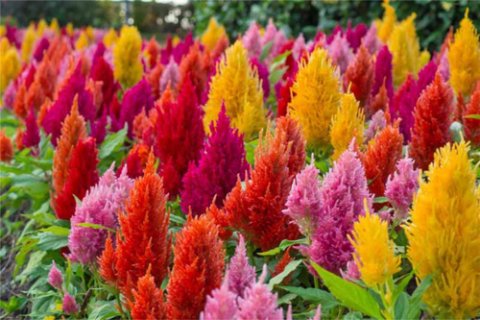Photo from Google search
The Celosia flower is an annual plant, also known as cockscomb or woolflower, and it blooms from mid-summer until the fall season. It is vibrant in colors and makes for a beautiful garden display. The Celosia flowers can be categorized into 3 main groups: crested, plumed, or spiked. Celosia can be grown inside, in a greenhouse, or on a porch. Make sure not to place them in centrally heated spaces as they will not be able to survive. Basic tips to care for the celosia plant:
- plant or pot the seedling in a well-drained soil
- place it in a sunny spot: the plant requires at least 7-8 hours of sun a day
- temperatures should vary between 20 and 25 degrees
- if you cannot water often, use mulch to keep moisture on the roots and make sure not to overwater to prevent rotting of the roots, high humidity levels will make your plant wither
- you can use a liquid fertilizer every 5-6 weeks to maintain plant growth
- there is no need to prune the plants but you can remove the fading blooms to make room for new ones
- you can plant Celosia with other flowers to create a nice colorful design in your garden, like marigolds or salvias.
Generally, Celosia is not prone to pests or diseases. Occasionally, you might spot spider mites on the leaves. This can be addressed by using rubbing alcohol, spraying the specific area with water, or water with a small amount of soap, or using Neem oil to repel the little bugs. Spider mites have several natural predators and in most cases, nature will take care of the issue by itself. You just need to be patient. And if you notice aphids infesting your flowers, ladybugs are the natural solution to that problem!
I was surprised to find out that the leaves of the Celosia argentea are soft and tasty when the plant is still young. The flowers and stems can be steamed, boiled, or stir-fried to be consumed like other vegetables. Some people add them to soups and stews. They are in fact a good source of calcium, phosphorus, protein, iron, and vitamins A and D. Some tribes in Africa, like the Masai, extract juices from the Celosia flowers and leaves to treat snakebites and eczema. In Asia, some people use its flowers and leaves to cure dysentery and wounds. It is also known that Celosia has anti-inflammatory and antioxidant properties and can medicate arthritis and heart disease.
Typically regarded as a symbol of love, resilience, good fortune, positive energy, and abundance, Celosia is perceived as a lucky charm in several cultures. In Hinduism, Celosia is associated with Lakshmi, who is the goddess of wealth, prosperity, and fortune. And anyone offering these flowers to the goddess in a religious ceremony will be granted good luck and blessings. The shape of the Celosia flower, which looks like a flame makes it an emblem of devotion and spiritual enlightenment. The Aztecs believed Celosia had healing powers and cured headaches and other ailments with it. In China, this flower is linked to the Rooster as a Zodiac sign. It signifies good luck and protection from evil spirits. Chinese highest-ranking officials are decorated with it as a symbol of high social status.
Happy gardening 🌱🌱🌱

